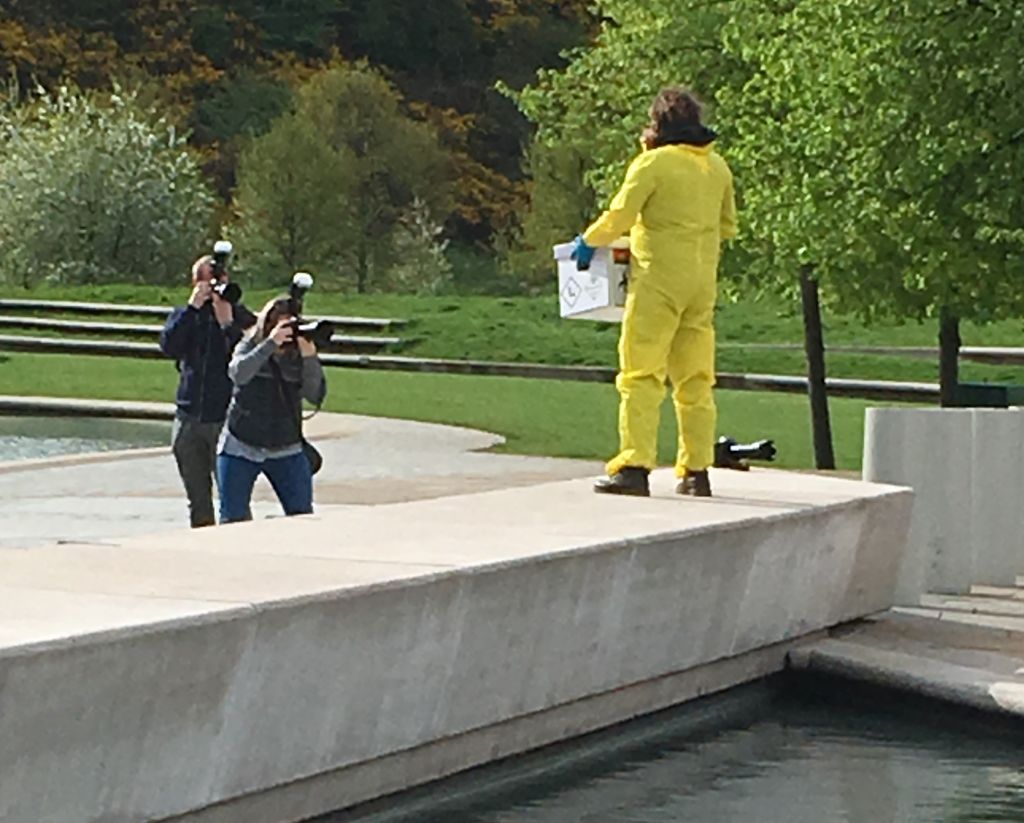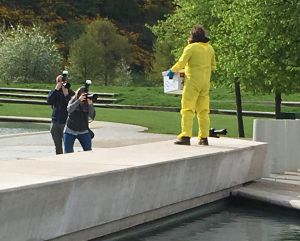reFLEXtion and a challenge: The Rural Economy & Connectivity Committee has come to an end with the Fisheries Minister giving evidence at the final session. In our opinion, he spoke well, and we hope alleviated all the Committee’s concerns.
Before we move off this subject (at least until the Committee’s report is published) we would like to make a couple of comments.
There does seem to be a view amongst MSP’s and some critics that doubling the salmon farming industry’s production will involve a doubling of the existing industry as it is. Aside from the fact that the industry strategy document for 2030 states a doubling of value, the reality is that the industry is dynamic and continues to evolve. The industry in 2030 will be a very different one from the industry today just as the industry today is very different to that of the 1990s.
There will be few that will remember the early salmon industry in Scotland. There was good reason why the early farms were located along the west coast and towards the heads of sea lochs. This can be described in one word – shelter. The first salmon cage collars were made of wood and in today’s terms were extremely flimsy. They needed to be sited in the most sheltered locations which was why they were at the head of the lochs. Today, no farming company would even consider such a location, but some farms still exist in these locations because companies are loathe to give up sites because every new application is met with opposition from the vocal minority.
The industry is slowly moving out of the lochs into open sea, yet still every application meets with opposition. Ben Hadfield from Marine Harvest told the Committee that the aspiration is to consolidate into fewer larger farms, yet even this doesn’t satisfy the critics, as we will discuss later. The industry will change. This is inevitable. It won’t be due to the findings of a Parliamentary Enquiry. It will happen as part of the evolving nature of salmon farming.
More importantly for us, at Callander McDowell, was that the single issue that pervaded the whole enquiry, as well as that of the ECCLR Committee, is that of sea lice and the impacts on wild fish. This is not surprising given that the enquiry was prompted by the Salmon & Trout Conservation petition demanding more controls on sea lice from salmon farms.
There has been much discussion about trigger levels, lice numbers, lice reporting including real time and enforcement, yet none of this seems important if sea lice from salmon farms have minimal impact on wild fish and the reasons for declining stocks can be attributed to other reasons. There was little discussion as to how much impact farms have on wild fish and in the case of the ECCLR Committee, such information that was supplied was ignored.
The fact is that the impacts of salmon farming on wild fish stocks is still extremely contentious. This is because the evidence is largely circumstantial. If a graph of increased salmon production is placed with one of declining wild stocks, the link appears incontrovertible but as one MSP pointed out, the graph doesn’t show cause. More significantly, if the graph is extended back in time, the decline of wild fish continues long before salmon farming became established on the west coast.
Given that the ECCLR Committee said that more research is required, we are still puzzled that the Marine Scotland Science £600,000 three-year smolt release study was never mentioned. This study has come to an end and has been written up. It is absolutely relevant to this enquiry as it intended to demonstrate how much impact salmon farms have on wild fish. Dr John Armstrong of MSS has repeatedly said that this experimental approach is the only way to determine these impacts, so we don’t see how this study cannot be considered as part of the enquiry. In our opinion, the only reason why this study has not been mentioned is because, for whatever reason, it has not shown that salmon farming is the key problem for wild fish. If it wasn’t for our interest, we suspect, this study would eventually be supressed. However, this will not happen. We will declare an interest and say that this is because MSS have stated that catch data cannot be used to determine the impacts of salmon farming on wild fish. This is despite refusing to meet to discuss our approach.
The REC Committee did mention that the wild fish sector and farming industry have polarised views. This is simply because the loudest voices from the wild fish sector, SA&TC also refuse to discuss the issues. It is their view or nothing. As regular readers of reLAKSation know, we have a book – Loch Maree’s Missing Sea Trout – which offers some alternative views. The book has been mentioned twice during the enquiry, but with no follow up questions. Since its publication, we have not had a single discussion with anyone from the wild fish sector as to the issues raised. It seems to us that if they are not acknowledged, they cannot be discussed. This is crazy. Surely, if the wild fish sector is so concerned about the state of wild fish stocks that some of the them are prepared to issue petitions and engage in major media campaigns, then why does this concern not extend to being willing to sit down for open discussion.
We would like to issue a challenge.
The Convenor of the REC Committee has declared an ‘interest’ in the wild fish sector. He is also part of this enquiry and will no doubt sign up to the Committee’s recommendations. He is therefore best placed to act as the catalyst to bring the wild fish and farming industry together to discuss the issues. We, at Callander McDowell have in the past made strenuous efforts to speak to wild fish people but with little success. If the Convenor wants to resolve the issues of salmon farming, then he must bring the wild fish sector to the table. We would suggest as a first step a one-day conference, mediated by an impartial academic, be organised where both sides can present their views with the aim of initiating subsequent discussion.
There is absolutely no reason why the salmon industry and wild fish sector cannot live and work together in harmony but there has to be a debate about the issues. As someone from the wild fish sector, the Convenor could make it happen. We challenge him to do so.
Sums don’t add up: We were recently notified by the REC Committee that our correspondence was to be included in a Freedom of Information request. We presume that the request had been made by campaigner Don Staniford since he freely advertises that he uses FOI as a method of investigating the salmon industry. Whilst he is keen to use information from others, he is not so willing to share information about himself. We have previously pointed out that it is unclear about how or who funds his activities. He does ask for public donations and any of these are paid into his personal bank account rather than the organisations he claims to represent. It is just as likely that one organisation is bank-rolling his campaigns.
This week Mr Staniford tweeted from his latest incarnation, Scottish Salmon Watch:
‘We’ll be delivering the petition to the Scottish Parliament on 9 May 2018 – please sign & share to make our message to save Scottish wild salmon as strong as possible. Now over 41,000 signatures!’
Subsequently, the Herald newspaper reported that campaigners are claiming salmon farmers are turning Scotland’s pristine seas into an open sewer. They want officials to routinely test the waste pumped out of farms for viruses and disease as they say that wild salmon are being killed off by disease and sea lice that plague commercial salmon farms.
The Herald goes on to say: ‘Consumer group ‘SumOfUS’ will deliver a 41,630 strong petition to Holyrood calling on the Scottish Government to bring in stricter rules’.
Senior campaigner Sondhya Gupta said ‘the farms supplying salmon to supermarket such as Tesco and Sainsbury’s made millions of pounds every year’.
She added: ‘The appalling conditions in their farms and processing plants are also putting wild fish at risk of disease and infestations like sea lice’.
The Herald article raises several issues which warrant closer examination.
Firstly, this group ‘SumOfUs’ have made some outrageous claims including the suggestion that the conditions in processing plants supplying Tesco and Sainsbury’s are appalling. Unlike Mr Staniford’s ‘organisations’ ‘SumOfUs’ employ a PR company with whom we have had several exchanges.
Specifically, we have asked for evidence of the appalling conditions at these processing plants after all, ‘SumOfUs’ have been very exact as to which processing plants they mentioned.
The PR company responded with a quote from Sodhya:
‘Sondhya Gupta, senior campaigner at SumOfUs, said: “Like almost all campaigning organisations, SumOfUs relies on information from its partners. We have full confidence in our evidence, and what it says about the problems in Scotland’s salmon farms. That’s what we really need to focus on – how the Scottish government plans to address the poisoning of its wild fish.”’
So, ‘SumOfUs’ have full confidence in their evidence although it comes from their partners, not themselves. However, they are not willing to share this evidence because they think the wider issue is more important, that is the poisoning of wild fish – but they won’t supply the evidence that this actually happens.
We reverted to the PR company asking again for the evidence or even the opportunity to speak to Sondhya Gupta. Unfortunately, Ms Gupta is unavailable to speak and the repeated request for evidence was ignored.
We will come back to questions about the credibility of ‘SumOfUs’ later.
Meanwhile, Don Staniford claimed he was going to deliver the petition to the Scottish Parliament whilst ‘SumOfUs’ were also to deliver it to Holyrood. We were keen to discover who would turn up. When the original programme of evidence was first announced, Mr Staniford said he would be organising a protest outside the Parliament although no further word on that appeared. On the day in question, the protest and delivery turned out to be a protest of one – Mr Staniford, although he had the company of two photographers.
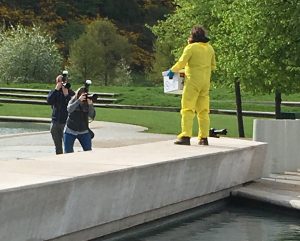
It turned out that this protest of one was also the delivery of the petition to the Scottish Parliament. Unfortunately, the petition was not delivered to the Parliament at all but to Green MSP Mark Ruskell and the exchange took place outside, not even within the building.
It would appear that Mr Ruskell does not even have to be convinced by the petition because according to the Herald, he had already demanded a moratorium on further fish farm expansion. In our opinion, Mr Ruskell has relied on Mr Staniford to supply information to support the Green Party case for greater control of salmon farming. For example, Mr Ruskell has asked the First Minister about the One Show TV programme in which Mr Staniford played a part. We understand from others that the Green Party have not been so willing to hear the other side of the debate. Certainly, they have not responded to our correspondence. We don’t even know if Mr Ruskell has visited a salmon farm. However, Mr Ruskell does sit on the ECCLR Committee, so if their report, even in part, reflects his views, it is not surprising that it is so critical of the salmon farming industry.
Following his one-man protest outside the Parliament which including handing over the ‘SumOfUs’ petition, which to the best of our knowledge has little in the way of supporting evidence, Mr Staniford attended the evidence session in the Committee Room. Rather surprisingly for such an extrovert campaigner, who is quick to visually enhance his protests, he did not use the opportunity to make a protest. Instead, he sat quietly making copious notes (Don is in black with his head down). There was not even an attempt to display a small banner.
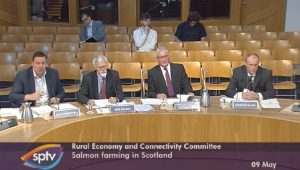
He then left the Parliament cutting a somewhat forlorn figure.
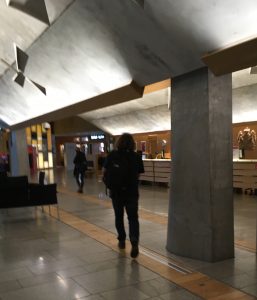
To the best of our knowledge, his protest received almost no coverage in the press. He is a one man protest movement.
However, he has become associated with the group ‘SumOfUs’. It describes itself as a community that exists to put bad corporations in their place. They have 32 members of staff who live in eleven different countries, but they are a US registered organisation.
Their campaigns range across the whole corporate sector from recyclable cups at Starbucks to Pepsi’s palm oil usage and depend on sign ups from their members and their members’ networks. It is therefore not surprising that ‘SumOfUs’ can produce 41,000 signatures. They rely on a global membership who readily sign the various petitions but who probably have little idea of the issues other than they are promoted as being bad.
They rely heavily on donations from their members, but they do receive funds from foundations such as the Packard Foundation and Tides. Interestingly, Packard have already spent millions on campaigns to demarket farmed salmon in the US market with claims that farmed salmon are dangerous for human health and the environment, whilst Tides helps fund the David Suzuki Organisation which is actively campaigning in Canada against the renewal of farming licences.
What we find of concern is that the ‘SumOfUs’ campaign, which won’t or can’t supply actual evidence to support their claims is sending a petition of over 41,000 people into the hands of a Green MSP who has already demanded a moratorium on salmon farming. It does seem that international activism is being directed towards Scotland by one single person and is being used to determine the future livelihoods of small fragile communities along Scotland’s west coast, without any hard evidence or knowledge. Instead, its only necessary to look at the way that the petition was handed over to be concerned that it is all show and very little fact.
We can only hope that the Scottish Parliament can see through this charade.
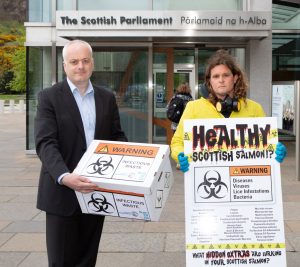
Note: we have been asked that if we use this photo to acknowledge the photographer
John Need – Award Winning Photography, 1 Summerhall, Studio 147, Edinburgh. EH9 1QD
M | 07756 178 947 W | http://www.JohnNeed.co.uk
Untrustworthy: The Sunday Times reported that supersizing salmon farms would be a disaster for Scotland. This stems from comments made at the REC Committee that the salmon industry would like to consolidate into fewer larger farms in more exposed locations. The story was repeated in the Scottish Sun the following day.
 Scottish Sun 7th May
Scottish Sun 7th May
Richard Luxmoore from the National Trust for Scotland told the Sunday Times that:
“Even if they could find these mythical remote offshore locations that have these kinds of tides — and I don’t think they exist — what you would have is basically a sea lice factory.
“It’s more difficult to control disease when you’ve got a bigger farm. If they increase the volume of fish, they will increase the problem of releasing sea lice larvae. What they are proposing is going to be more detrimental to wild fish — especially wild salmon and sea trout — than the situation now.”
Luxmoore said stronger currents could disperse waste but branded Sepa’s thinking flawed, arguing that faeces would form “hot spots”.
Following his comments to the ECCLR Committee, we wrote to Dr Luxmoore and we subsequently sent him a copy of the book – Loch Maree’s Missing Sea Trout.
We have not received any acknowledgement or response and whilst, this is not unexpected from the wild fish lobby who are reluctant to enter into any debate, we had hoped that the National Trust for Scotland would be more willing to debate the issues. It seems that we were wrong. It appears that if an organisation is anti-salmon farming, whether it’s a political party, a conservation charity or a wild fish interest group, the action is the same –expound your views in the press but don’t whatever engage in discussion.

